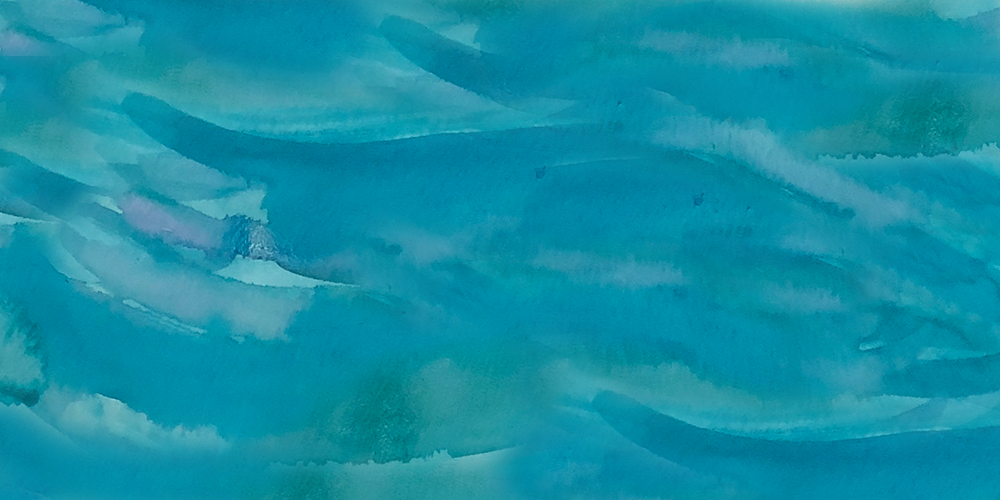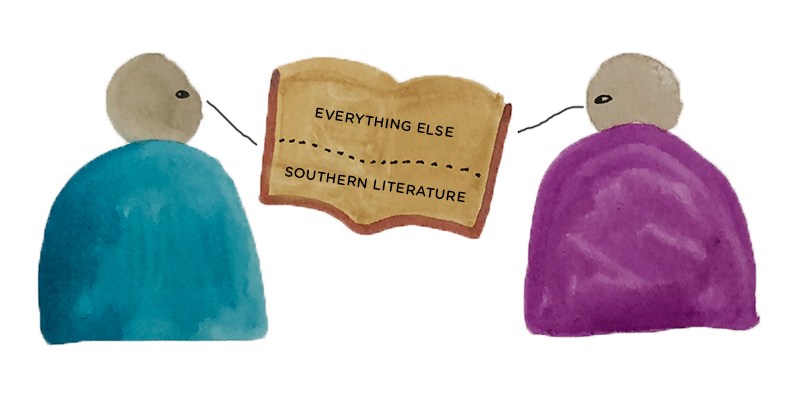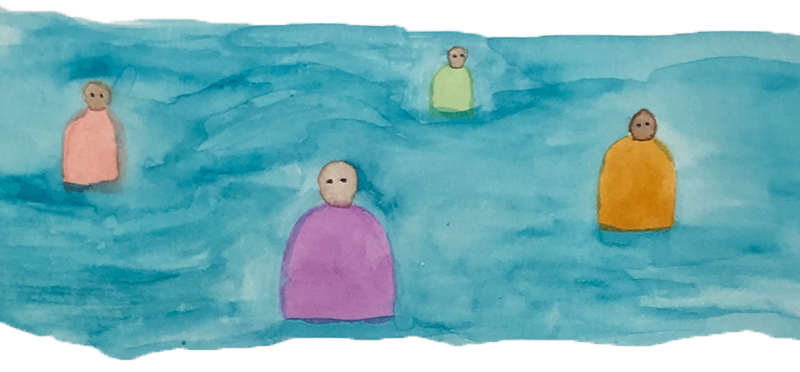it rained, fell like Jericho
its walls. Water brokethrough the roof. All
our pails were full —Kevin Young, “Flood,” from Dear Darkness
“In the morning,” wrote a wistful Henry David Thoreau, in A Week on the Concord and Merrimack Rivers, “the river and adjacent country were covered with a dense fog, through which the smoke of our fire curled up like a still subtler mist.” And so the Merrimack River, which young Henry was surveying with a friend in 1839, emerged in print as an idealized thing, a natural phenomenon of a Massachusetts ecosystem inseparable from human activity — mingling its elegant vapor with the “smoke of our fire” — while being warmly respectful of all surrounding features. Nice.
I recalled these dulcet Thoreauvian reveries while at the same time observing the Merrimack’s cantankerous counterparts: the violent rivers that wreak Biblical havoc in the literature of the American South. Rivers do not gracefully ebb and flow through the southern literary landscape; instead, they swell into angry ribbons of mud thickened sludge, rising with ruthless force to exceed their boundaries and submerge human ambition and hubris in the same gutted delta, washing the folk away — physically and emotionally — alongside the precarious detritus of their betrayed surroundings. Nothing calming about them. A river in Thoreau’s oeuvre invites admiration; but in the southern variation it becomes, as Eudora Welty put it in The Eye of the Story, the South’s “describable outside,” the very essence of place “that defines us, willy-nilly, to others.”
Once you key into that definition, the distinction between the Merrimack and its southern brothers takes on more than anecdotal regional significance. Whereas rivers in the literature of the north urge us, as Whitman cheerily suggested in “Crossing Brooklyn Ferry” (Leaves of Grass), to be “refreshed by the gladness of the river and the bright flow,” in the iconic work of southern literature they are a collective phenomenon that, as Faulkner explained in Absalom, Absalom!, “runs not only through the physical land of which it is the geological umbilical, not only runs through the spiritual lives of the beings within its scope, but is very Environment itself, which laughs at degrees of latitude and temperature . . .” The southern river does not, in other words, merely coexist; it coopts, swallows, defeats, humiliates, drowns.
The starkness of this difference is instructive in a mildly academic sense as well. Anyone who reads southern literature with any seriousness will be nagged by annoyingly basic questions such as, “what the hell is southern literature? What exactly makes it southern?” And if you don’t come to these questions on your own, someone very meddling will lead you to them. No definitive answers are forthcoming here. But whatever those qualities are, reading the region’s rivers is not a bad way to broach the perpetual quest to define what so often eludes definition but somehow, whatever it is, makes southern literature, loaded term that it is, southern.
For me, Faulkner’s notion of a river becoming the place itself is nowhere more evident (outside of other Faulkner) than in Cormac McCarthy’s 1979 masterpiece, Suttree, a novel in which the Tennessee River becomes a slate grey protagonist. There’s so much we don’t know about Cornelius Suttree. But we do know this: his twin died at birth. We also know this (like Leo Bloom in Ulysses) Sut lost a young son to an estranged wife. And it seems safe to say that these losses may have influenced his choice to wander about with grieving aimlessness — leaving behind his former life of material comfort and social privilege to inhabit the shithole riverbank communes of Knoxville.
McCarthy uses the river to evoke the quiet pain that gradually nudges Suttree beyond hope for redemption “in this world.” During “his third year on the river,” as Sut “gazed out at the swollen river coming down from gutted upcountry and sliding past with a slaverous mutter seethe,” he saw that it was,
Bearing along garbage and rafted trash, bottles of suncured glass wherein coronas of mauve and gold lie exploded, orange peels ambered with age. A dead sow pink and bloated and jars and crates and shapes of wood washed into rigid homologues of viscera and empty oilcans locked in eyes of dishing slime where the spectra wink guiltily.
And then:
“One day a dead baby.”
Merciless prose. The concrete truths offered up by the sober river taunt the southern impulse for redemption. We see this happening vividly, again in Suttree, when Sut, sitting on the riverbank next to an evangelical lay minister stumping for grace, encounters an unidentified man being baptized by a wild and itinerant preacher. The scene:
The preacher had the man up by the collar. He was sputtering and reeling about and looked half crazy. The preacher steadied him by the forehead, intoning the baptismal service.
Suttree, disgusted with this ritualistic display of religiosity, gets up and starts to walk away, “You ain’t fixin to leave are ye?,” asks the old man sitting beside him. “I sure as hell am,” says Sut. To which the narrator intervenes to remind us, “Suttree knew the river well already and he turned his back to these malingerers and went on.” Nobody in this land, despite every effort to the contrary, can be born again — especially not in a trash-strewn river where these malingerers indulge their fantasies.
Even a lazy northern river cannot evade the southerner’s tendency to understand the benthic nature of its inherent fatalism. We get a bitter taste of this transference in The Sound and the Fury, when Quentin Compson, the Harvard freshman whose education is funded by the sale of a ragged piece of Mississippi property stolen from Indians and enriched by slavery, faces his own appalling destiny on the Anderson Bridge on the Charles River. Weights on his ankles, broken watch in his pocket, he leaps to his death. Others drown for salvation, as Flannery O’Connor shows us when, in her short story “The River,” a young boy who calls himself Bevel decides to “Baptize himself and keep going this time until he found the Kingdom of Christ in the river.” At first, “the river would not have him.” But little Bevel persists and soon “the waiting current caught him like a long gentle hand and pulled him swiftly forward and down.”
•
The all-encompassing nature of rivers in southern literature does more than evoke death and destruction. It can, in its ability to swallow whole its environment, also play a kind of leveling democratic role in the midst of impending and inevitable doom (politics sure as hell can’t do it). The Mississippi River ferociously goes rogue in Faulkner’s novella Old Man. As it surges, the protagonist (whom we only know as “the convict”) maneuvers his skiff to a lone levee where a congregation of escaped prisoners has gathered, watching the water rise with a sense of foreboding so familiar it’s part of the culture, like manners and humidity. Faulkner writes,
When they reached the top of the levee they could see the long line of khaki tents, interspersed with fires, about which people — men, women, and children, Negro and white — crouched and stood.
An impromptu interracial community congregates on smaller plots of dry ground as the floodwaters rise. Nature crosses cultures, indifferently and without bias, and in so doing demands a different sort of transcendental interpretation. The suffering, which exceeds race, class, gender, and ethnicity, allows for a rare flash of hope to illuminate a doomed landscape. As more convicts arrive, so does the perpetual accompaniment of universal suffering: music. Faulkner continues,
When the engine shut off the faint plinking of a guitar came across the water . . . The sound of the guitar had not ceased and now the convicts saw him — a young, black, lean-hipped man, the guitar slung by a piece of cotton plowline about his neck.
One could write a lengthy book about that single cotton plowline. But for now: As this band of convicts, including this clear reference here to Leadbelly (and the Great Flood of 1927) comes to life, the river rises and churns and turns the makeshift village into “a toy and pawn on a vicious and inflammable geography.” Faulkner, as if awed by the very force he describes, allows it to have the final word:
The river was now doing what it liked to do, and waited patiently the ten years in order to do so, as a mule will work for you for ten years for the privilege of kicking you once.
But such leveling, as history shows, is something of a fiction. “If it keeps on raining, the levee’s going to break . . . ” most of us think Led Zeppelin, and the hypnotic lead-in to Robert Plant’s opening lyrics to track eight on the band’s 1971 legendary album IV. But the song was written and recorded in 1929 by Kansas Joe McCoy and Memphis Minnie, with the effects of the flood of 1927 still searing the South. And so the next line, “when the levee breaks I’ll have no place to stay” takes on new meaning. It reminds us that whites had plenty of places to stay. It was black Americans who were stuck to suffer the consequences of the flood. And they were stuck because they were living alongside the river down which their descendants were once sold.
Such troubled waters in southern literature easily flow from literature to the realm of visual art. Two artists in particular — Eudora Welty the photographer and painter David Bates — work in tandem (not by design) to weft southern families to the warp of rivers that refuse to flow free from human drama. In Eudora Welty: Photographs we find two images from the 1930s, muted in their power, of a family living literally on top of Jackson, Mississippi’s Pearl River. Titled “Houseboat Family” and “Shantytown Life,” they show a white family, hard faces hidden in soft shadows, inhabiting a river that almost mocks them with its calmness. It would not last. Welty would be in her 80s, and the shantytowns would be long gone when, on Easter day 1979, the Pearl River rose 15 feet above flood stage and did what rivers in the South habitually do: submerged the entire city. Studying the proximity of the coffee-colored Pearl and the wooden shacks under which they flow in Welty’s elegant shots, it feels as if that dreadful outcome is not only foreordained, but merely less than a moment away.
David Bates, arguably one of America’s most under-appreciated artists, provided an emotionally taut glimpse of the disaster’s aftermath. In a way, the entire history of writing about rivers in southern literature presages the predictable outcome of Katrina. Bates, who painted a series of canvases for his series, The Deluge (see David Bates, published by the Modern Art Museum of Fort Worth), somehow manages to freeze the essence of that tragedy as if he were some kind of swamp Picasso. The rising tide consumes the pre-existing poverty — the rusted out cars and shacks of the Ninth Ward are now, finally, noticed — while noble and attenuated black men and women, all rendered in thick, tangible brushstrokes, go about the task of survival. One considers Thomas Hart Benton’s working stiffs as the destruction and death around the painted flood victims reveal a wrenching dignity that only total defeat makes plausible.
•
Perhaps it shouldn’t, but for those so inclined, the academic question eternally returns in the wake of these far-flung observations — what is southern literature? Or, more ambitiously, what does it mean to be southern? The question seems so abstract as to be ridiculous, which is why most critics stammer and say “gothic.” But, fact is, as long as there has been southern literature there have been expectations to answer this question. And, frankly, gothic just won’t do.
How about benthic? Indeed, one could do worse than read the inky rivers running through the art and expression of the American South, much less go to their depths. One might, in so doing, draw some fairly decent conclusions about what the historian C. Vann Woodward, in The Burden of Southern History, called “peculiarities that set [the South] apart as unique.” Maybe this: The South has no room for utopian thought. Or this: The South is fallen and needs to be washed clean of its original sin before rising again. Or could it be something more dire? Something more benthic.
As the poet Kevin Young wrote, in “East Jesus,” from For the Confederate Dead: “The South knows ruin & likes it thataway.” The river, which Thoreau always honors, wants you, down South, to be cowed by its power. •
All illustrations by Isabella Akhtarshenas.






